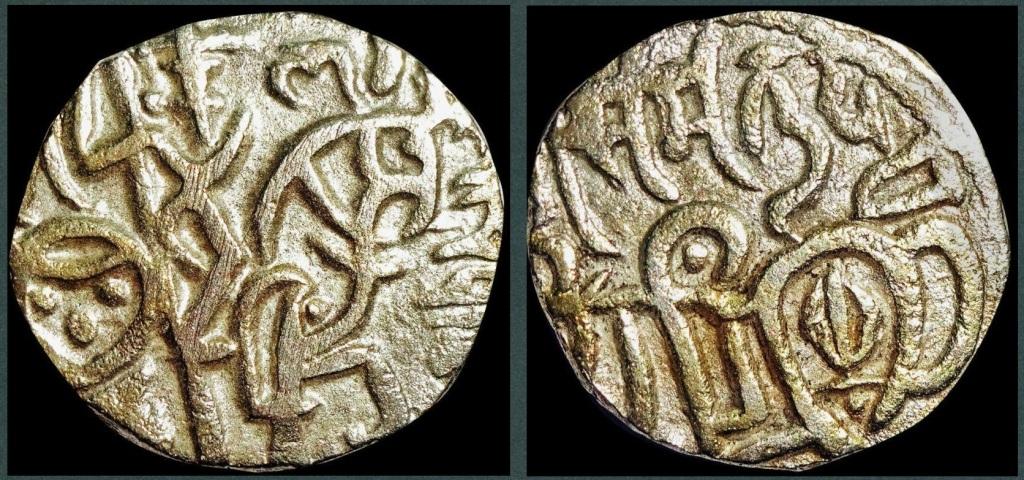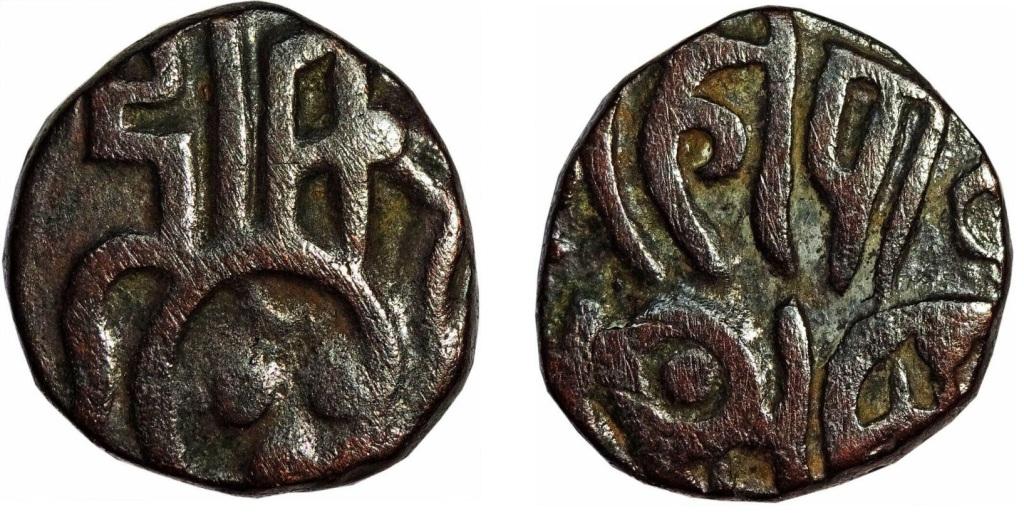| |
| Tomara |
| |
The Tomara (also called
Tomar in modern vernaculars because of schwa deletion) were an Indian
dynasty who ruled parts of present-day Delhi and Haryana during 9th-12th
century. Their rule over this region is attested to by multiple inscriptions
and coins. In addition, much of the information about them comes from
medieval bardic legends, which are not historically reliable. They were
displaced by the Chahamanas of Shakambhari in 12th century.
The Tomara territory included parts of the present-day Delhi and Haryana. A
13th century inscription states that the Tomaras ruled the Hariyanaka (Haryana)
country before the Chahamanas and the Shakas (Muslims in this context). A
14th century inscription states that they built the Dhillika (Delhi) city in
the Hariyana (Haryana) state , and that their rule was followed by that of
the Chahamanas and the mlechchha Sahavadina (Shihab ad-Din).
The Tomaras are known from some inscriptions and coins. However, much of the
information about the dynasty comes from medieval bardic legends, which are
not historically reliable. Because of this, the reconstruction of the Tomara
history is difficult. |
| An important Sultanate in
north-central India; significant as (at times) a large imperial state acting
as a buffer between Mongol and Timurid aggression toward the rest of India. |
| Abul Fazl's Ain-i-Akbari /
Bikaner manuscript mentions below ruler names of this dynasty. The names
mentioned in the bracket are from Gwalior
manuscript of Khadag Rai and
Kumaon-Garhwal manuscript. |
| |
| |
- Tomaras of Dhillika (Delhi)
- Ananga Pala (Bilan
Dev)....................................736
- 754
- Vasu Deva..................................................754
- 773
- Gangya (Ganggeva)..........................................773
- 794
- Prithivi Pala (Prithivi
Malla /
Prathama /
Mahi Pala)......794
- 814
- Jaya Deva (Saha
Deva /
Jadu Pala)..........................814
- 834
- Nira Pala (Hira
Pala /
Indrajita I /
Nai Pala).............834
- 849
- Udiraj (Adereh /
Nara Pala
/ Jaya Deva
Pala)...............849
- 875
- Vijaya (Vacha /
Indrajita II
/ Chamra Pala)................875
- 897
- Biksha (Anek /
Vacha Raja
/ Bibasa Pala)...................897
- 919
- Riksha Pala (Vira
Pala /
Sukla Pala).......................919
- 940
- Sukh Pala (Nek
Pala / Go-Pala
/ Teja Pala).................940
- 961
- Gopala (Tillan
Dev /
Mahi Pala)............................961
- 979
- Sallakshana Pala (Suvari
/ Sursen).........................979
- 1005
- Jaya Pala (Osa
Pala /
Jaik Pala)..........................1005
- 1021
- Kunwar Pala (Kumara
pala).................................1021
- 1051
- Ananga Pala (Anek
Pala)...................................1051 - 1081
- Vijaya Pala (Vijaya
Sah / Teja Pala)......................1081
- 1105
- Mahi Pala (Mahatsal
/ Jyun Pala)..........................1105
- 1130
- Mahipala captured Thaneswar, Nagarkot and Hansi.
He is said to have contributed a lot to development of Delhi. There is
an area called “Mahipalpur” near the Indira Gandhi International airport
in Delhi.
- Akr Pala (Akhsal /
Mukund Pala
/ Ane Pala)................1130
- 1150
- Madanapala................................................1150
- 1152 opposed by..
-
Chauhan dynasty (Chahamana)...............................1152
- 1192
-
The Ghurid Empire.........................................1192
- 1206
-
Delhi Sultanate...........................................1206
- 1526
-
The Mughal Empire.........................................1526
- 1540
-
Suri......................................................1540
- 1555
- Mughal Empire
(restored), British and then
Republic of India thereafter...
|
| |
|
 |
Deyell 187 Jital.
Year:
c. 1051 - 1081 CE. Weight
3.06 grams.
Metal:
Billion.
Diameter: 16.15 mm. Edge:
Plain. Alignment:
Medal. Mint:
Delhi. |
|
Obverse:
"श्री अनंगा पाल देव जी"
(Sri Ananga Pala Devah Ji)
written in Devanagari
at the top. Horseman
bearing lance on caparisoned horse moving towards right. Three dots of harness on horse's rump.
Reverse:
"श्री सामंत देव" (Sri Samanta Deva) written
in
Devanagari above
Zebu at the top section.
Recumbent bull facing left,
wearing jhula,
(saddle-cloth).
Club-like trisula
(trident) symbol on the rump.
Mintage:
N/A.
Mintage Years:
N/A.
Ruler: Ananga
Pala Deva (1051 - 1081). |
|
 |
Jital.
Year:
c. 1105 - 1130 CE. Weight
3.26 grams.
Metal:
Copper.
Diameter: 13.50 mm. Edge:
Plain. Alignment:
Medal. Mint:
Delhi. |
|
Obverse:
Horseman riding
caparisoned horse towards right. Three dots of harness on
horse's rump.
Reverse:
"श्री माही पाला" (sri ma hi pa la) written
in
Devanagari above
Zebu at the top section.
Recumbent bull facing left,
wearing jhula,
(saddle-cloth).
Mintage:
N/A.
Mintage Years:
N/A.
Ruler: Raja
Mahipala (1105 - 1130). |
|
| |
| |
| |
| Early
Indian coins:
British India coins:
Coins of Indian Princely States and other
colonies:
Coins of "Republic of India" sorted under below
Presidential rulers:
Others:
|
| |
| |
|
|
| |
|
|
| Countries
/ Territories |
| |
|
Chiefa Coins |



